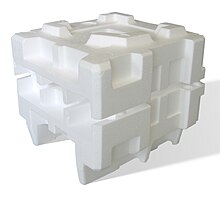Styrofoam: Difference between revisions
m Dating maintenance tags: {{Cn}} |
|||
| Line 29: | Line 29: | ||
Dow also produces Styrofoam as [[structural insulated panel]]s for use by [[florist]]s and in craft products.<ref>{{cite web|url=http://craft.dow.com|title=STYROFOAM Brand Foam Crafts| accessdate=2010-12-31}}</ref> Dow insulation Styrofoam has a distinctive blue color; Styrofoam for craft applications is available in white and green. |
Dow also produces Styrofoam as [[structural insulated panel]]s for use by [[florist]]s and in craft products.<ref>{{cite web|url=http://craft.dow.com|title=STYROFOAM Brand Foam Crafts| accessdate=2010-12-31}}</ref> Dow insulation Styrofoam has a distinctive blue color; Styrofoam for craft applications is available in white and green. |
||
Styrofoam coffee cups take significantly less energy to produce, ship and dispose of. According to Michael Hocking’s 1994 Life Cycle Comparison of coffee cup types, you’d need to use a ceramic coffee mug over 1,000 times before the “energy per use” equals that of a styrofoam cup.<ref>{{cite web|url=http://womanitely.com/coffee-cup-eco-friendly/|title=Ceramic, Paper or Styrofoam? What Coffee Cup Is the Most Eco-Friendly?|publisher=Womanitely|accessdate=2016-09-16}}</ref> |
|||
Styrofoam can be used under roads and other structures to prevent soil disturbances due to freezing and thawing.<ref>{{cite web|url=http://building.dow.com/na/en/applications/geotech/index.htm|title=Geotechnical applications of Styrofoam|publisher = Dow Chemical| accessdate=2009-10-28}}</ref><ref>{{cite web|url=http://www.alaskool.org/resources/regional/nw_reg_pro/permafrost.html|title=Engineering considerations when building on permafrost|accessdate=2007-08-30}}</ref> |
Styrofoam can be used under roads and other structures to prevent soil disturbances due to freezing and thawing.<ref>{{cite web|url=http://building.dow.com/na/en/applications/geotech/index.htm|title=Geotechnical applications of Styrofoam|publisher = Dow Chemical| accessdate=2009-10-28}}</ref><ref>{{cite web|url=http://www.alaskool.org/resources/regional/nw_reg_pro/permafrost.html|title=Engineering considerations when building on permafrost|accessdate=2007-08-30}}</ref> |
||
Revision as of 18:41, 19 September 2016


Styrofoam is a trademarked brand of closed-cell extruded polystyrene foam currently made for thermal insulation and craft applications. It is owned and manufactured by The Dow Chemical Company.[1]
In the United States and Canada, the word styrofoam incorrectly refers to expanded (not extruded) polystyrene foam, such as disposable coffee cups, coolers, or cushioning material in packaging, which is typically white and is made of expanded polystyrene beads.[1] The term is used generically although it is a different material from the extruded polystyrene used for Styrofoam insulation. The Styrofoam brand polystyrene foam, which is used for craft applications, can be identified by its roughness and the fact that it "crunches" when cut. Additionally, it is moderately soluble in many organic solvents, cyanoacrylate, and the propellants and solvents of spray paint. A tradename for polystyrene foam is Thermocol, created by BASF for expanded polystyrene.
History
In 1941, researchers in Dow's Chemical Physics Lab found a way to make foamed polystyrene. Led by Ray McIntire, they rediscovered a method first used by Swedish inventor Carl Georg Munters.[2] Dow acquired exclusive rights to use Munters' patents and found ways to make large quantities of extruded polystyrene as a closed cell foam that resists moisture.
Uses

Styrofoam is composed of 98% air, making it lightweight and buoyant.[3] Because of its insulating properties and buoyancy, it was adopted in 1942 by the United States Coast Guard for use in a six-person life raft.
Styrofoam has since found a variety of uses. Dow produces Styrofoam building materials, including varieties of building insulation sheathing and pipe insulation. The claimed R-value of Styrofoam insulation is five per inch.[4]
Dow also produces Styrofoam as structural insulated panels for use by florists and in craft products.[5] Dow insulation Styrofoam has a distinctive blue color; Styrofoam for craft applications is available in white and green.
Styrofoam coffee cups take significantly less energy to produce, ship and dispose of. According to Michael Hocking’s 1994 Life Cycle Comparison of coffee cup types, you’d need to use a ceramic coffee mug over 1,000 times before the “energy per use” equals that of a styrofoam cup.[6]
Styrofoam can be used under roads and other structures to prevent soil disturbances due to freezing and thawing.[7][8]
Environmental effects

The EPA and International Agency for Research on Cancer consider styrene a possible human carcinogen.[9][10] The National Bureau of Standards Center for Fire Research found 57 chemical by-products released during the combustion of expanded polystyrene foam.[11] On July 1, 2015, New York City became the largest city in America to attempt to prohibit the sale, possession and distribution of single-use polystyrene foam (the initial decision was overturned on appeal).[12] In San Francisco, supervisors approved the toughest ban on Styrofoam in the US which goes into effect Jan. 1, 2017. The city Department of the Environment can make exceptions for certain uses like shipping medicines at prescribed temperatures.[13]
Styrofoam-eating worms
In 2015, researchers discovered that mealworms, the larvae form of the darkling beetle, could digest and subsist healthily on a diet of Styrofoam.[14] About 100 mealworms could consume between 34 and 39 milligrams of Styrofoam in a day. The droppings of mealworm were found to be safe for use as soil for crops. Superworms (Zophobas morio) are also reported to eat styrofoam.[citation needed]
See also
- List of generic and genericized trademarks
- National Inventors Hall of Fame
- Resin identification code
- Structural insulated panel
- Styrophone
References
- ^ a b "STYROFOAM™ - It's Not a Cup" Dow Chemical Company
- ^ Boundy, Ray H.; Amos, J. Lawrence (1991). A History of the Dow Chemical Physics Lab. New York: Marcel Dekker, Inc. pp. 117–128. ISBN 0-8247-8097-3.
- ^ "What is the Difference between EPS Polystyrene and (styrofoam)?".
- ^ Dow Announces New Technology for STYROFOAM Insulation
- ^ "STYROFOAM Brand Foam Crafts". Retrieved 2010-12-31.
- ^ "Ceramic, Paper or Styrofoam? What Coffee Cup Is the Most Eco-Friendly?". Womanitely. Retrieved 2016-09-16.
- ^ "Geotechnical applications of Styrofoam". Dow Chemical. Retrieved 2009-10-28.
- ^ "Engineering considerations when building on permafrost". Retrieved 2007-08-30.
- ^ epa.gov
- ^ inchem.org
- ^ highcountryconservation.org
- ^ msnbc.com
- ^ "S.F. supervisors OK toughest ban on foam packaging in U.S." Retrieved 2016-06-30.
- ^ news.stanford.edu
